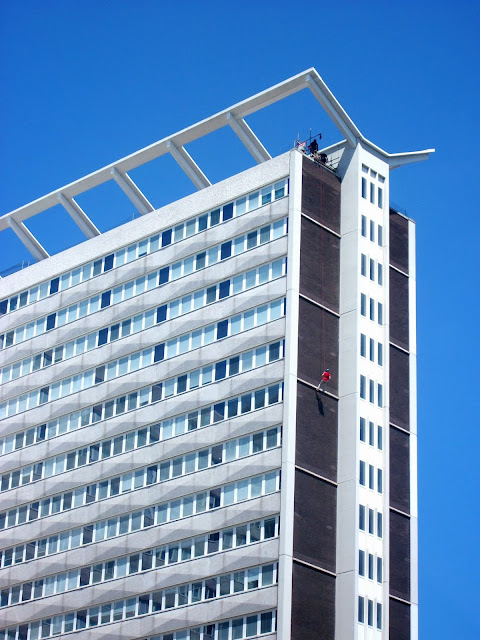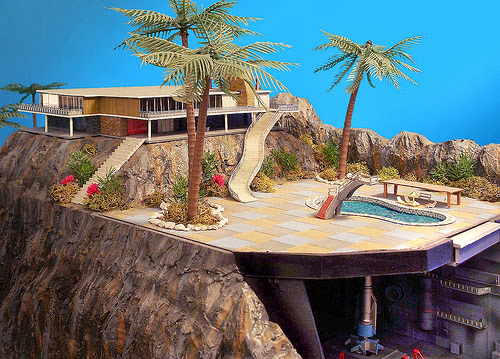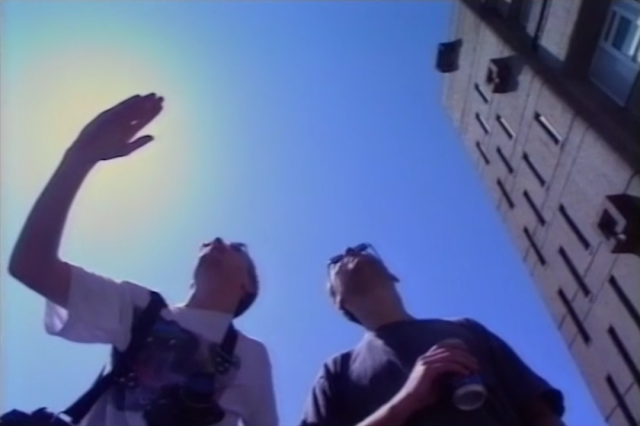Who doesn't love a trilogy? This wasn't even intended to be one, but then when I started out I didn't realise the sheer amount of gems there were still to be uncovered. And so here it is, the final installemnt of my trio of Ladybird modernism posts: you can see the first one
here and the second
here.
I love classic Ladybird books from the sixties and seventies. Their preoccupation with all things modern has been rather overlooked in
the more familiar nostalgic mist of dads in sheds, pet dogs and kids making crafts in a suburban semi. In this, the final installment of my appreciation, I'm focussing on some of the most hard-edged facets of modernism yet...
 |
| 1. System building, using large prefabricated units bolted together, was the truth behind the high-rise boom of the 60s and 70s. This is from People At Work: the Builder (1965) illustrated by John Berry. |
 |
| 2. Here's a power station, from The Public Services: Electricity (1966) illustrated, again, by the masterful John Berry. |
 |
| 3. There are a lot of brilliant Ladybird books that celebrate postwar aircraft, which just happens to be one of my other obsessions. Here's a Vickers Viscount and a control tower in the vein of Frederick Gibberd's for London Airport, from The Story of Flight (1960) illustrated by Robert Ayton. |
 |
| 4. Here's two for the price of one. The control rooms above and below are both from The Public Services: Electricity (1966) illustrated by John Berry. I love the geometric ceiling on the one above, and the banks of wooden tech in the pic below. |

 |
| 5. Here's a draughtsmen's office (no draughtswomen in evidence) from People at Work: the Road Makers (1967), with yet more John Berry detail and warmth. |
 |
| 6. Here's a series of flyovers, again from People at Work: the Road Makers (1967), illustrated by John Berry. Such high tech roads, such low-tech cars... |
 |
| 7. This charming brutalist basement is from People At Work: the Builder (1965) illustrated by John Berry. It's less classic Ladybird, more a random snap at the end of your 110 camera film, where you thought you'd just been winding it on. |
 |
| 8. One of the greatest modern buildings in Britain, captured beautifully by Bernard. Robinson, from How It Works: The Telephone. This is a later reissue, as it was the Post Office Tower in earlier versions of the book. |
 |
| 9. And, yes, another of the greatest modern buildings in Britain, Coventry Cathedral, inside and out (see picture below too). These beautiful illustrations of Basil Spence's masterpiece are by Robert Ayton, in the mealy-mouthed The Story of Our Churches and Cathedrals (1964). |
 |
10. And where better to end than in the future? This home of the future is half lunar module, half Pompidou Centre. Bernard Robinson's illustration is from Homes (1975).
|
























Hello John,
ReplyDeleteThank you for these reminders of the peerless Ladybird books. The "modern airport" depicted above looks to me like the terminal building of the former Speke Aerodrome (now the Crowne Plaza Liverpool John Lennon Airport Hotel, to name but a few). There's a photo here -- http://www.ipernity.com/doc/rogergw/36399764 .
Regards,
Roger
Love the future house; built in '75 and the poor sod still can't find the door...
ReplyDelete